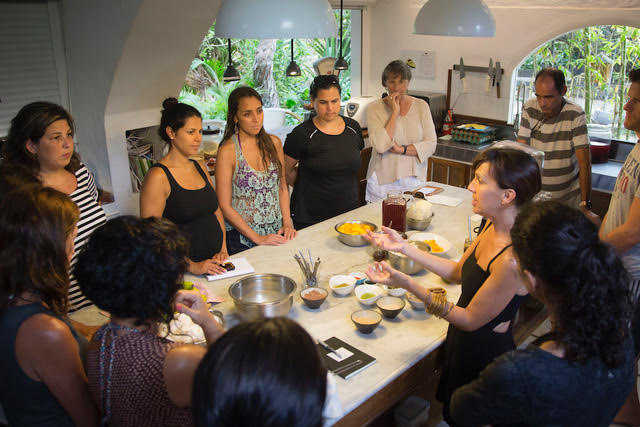I have been guiding people through various liquid fasts for the last 5 years and I am still continually inspired and excited by the way people respond to fasting. Here is a testimonial from one of the participants during the mindful fasting period of my 7-day home detox program.
“I've never felt better and super focused - totally cleared out my 3 years blocked up email inbox, I GOT SO MUCH DONE YESTERDAY. I've been suffering from fatigue for a year and it feels cleared, I actually feel high, like I'm on plant drugs, I'm literally in 8th gear but also feel really grounded…”
I have repeatedly witnessed such experiences with my clients during the fasting days of the program. Now obviously, the issue of physical hunger does arise during a fast, and yes, it can be a force to be reckoned with. However, hunger is significantly less of an issue than people fear it will be. In fact, it is the fear of being "starving" that is the biggest block for people wanting to experience a fast.
But here’s the thing, the experience of hunger - as with anything we don’t like when viewed with the appropriate mindset - can provide a wide array of opportunities for personal growth. By leaning into the experience of hunger, by examining it and appreciating it, I have found that the act of fasting, beyond its multitude of physical benefits, also provides an exceptional platform for developing an accelerated mindfulness practice -- in under 36-hours.
FASTING 101
Just to clarify, fasting is an effective and safe method of detoxifying the body. There are hundreds of scientific and independent studies on the practice of fasting as a way of healing the body and as a way to fight off illness and other degenerative diseases. Fasting provides a period of concentrated physiological rest during which time the body can devote all self-healing mechanisms to repairing and strengthening biological functions and damaged organs. Fasting accelerates and supports the body's natural process of cleansing the cells of accumulated toxins and waste products. A fast can be anything from 1-10 days and beyond. A person can fast on one specific food type or liquid or a combination or simply water intake.
“Fasting is the world’s most ancient and natural healing mechanism. Fasting triggers a truly wondrous cleansing process that reaches right down to each and every cell and tissue in the body.”~ Evart Loomis M.D.
MINDFULNESS: BY DEFINITION
I learned from Forbes that in 2016 more than 677 papers on mindfulness were published in scientific journals (up from 47 published a decade earlier) which has led to a $4-billion-dollar industry. This means that it’s clearly something the collective is benefiting from. It’s also ironic seeing that it’s about as basic in origin and practice as a trend can be. Here are some of the best definitions of Mindfulness I could gather up:
“Mindfulness is the act of being intensely aware of what you’re sensing and feeling at every moment – without interpretation or judgment.” ~Mayo Clinic
“Mindfulness means maintaining a moment-by-moment awareness of our thoughts, feelings, bodily sensations, and surrounding environment.” ~ Greater Good Science Center at the University of California at Berkeley
“The practice of maintaining a non-judgmental state of heightened or complete awareness of one’s thoughts, emotions, or experiences on a moment-to-moment basis.”~ Merriam-Webster Dictionary
“Mindfulness is the basic human ability to be fully present, aware of where we are and what we’re doing, and not overly reactive or overwhelmed by what’s going on around us.” ~ Mindful.org
“Mindfulness shows us what is happening in our bodies, our emotions, our minds, and in the world. Through mindfulness, we avoid harming ourselves and others.” ~ Zen Master, Thich Nhat Hanh
“Mindfulness isn’t just about knowing that you’re hearing something, seeing something, or even observing that you’re having a particular feeling. It’s about doing so in a certain way – with balance and equanimity, and without judgment. Mindfulness is the practice of paying attention in a way that creates space for insight.” ~ World-renowned meditation teacher and author, Sharon Salzberg
Okay, so point being, mindfulness is BEING IN IT. Not fixing it, not remedying it, not distracting it, not hiding it, just being aware of what IS.

MINDFUL FASTING
For many years, during the fasting periods of my programs, I would provide tips and hacks to help participants not feel hungry. Luckily, much less than expected to everyone’s delight, but I still wanted to provide all the tools possible to prevent my clients from feeling something they didn’t want to feel. And then it hit me, maybe they should also know that they can choose to just BE HUNGRY when they are hungry. Just be in it, really in it. The following are some of the ways I now offer to my clients to embrace the mindfulness approach to fasting; to just be, hungry. Here are three different mental approaches to fasting with intention, with presence and mindfulness.
GRATITUDE
FIRST AND FOREMOST: You can be extremely grateful that your experience of hunger is BY CHOICE and that this is a process you are willingly participating in for the purpose of your enhanced health and wellbeing. You can be extremely grateful that you are not actually “starving”, a verb that means suffering or dying from hunger/lack of nutrition, but more accurately temporarily experiencing the feeling of hunger. You can then go even deeper and feel the feeling of hunger as perceived by millions of our global citizens every day and at this very moment. This includes people of all ages and all countries, even people in your own country, your own community and maybe even just around the corner from you (this can be quite a revolutionary consciousness pivot and humbling to boot).
Sit quietly for 5-10 minutes and allow this shared present-moment experience to ignite compassion within your entire body, reaching down into all your cells and give deep thanks for the impermanence of this feeling in your body and in your life experience.
EXAMINE IT UP CLOSE AND PERSONAL
Physically, when your body is expecting food and the digestive enzymes are active in your gut, it will send hunger messages to the brain. One needs to be fasting for approximately 3 days before these signals slow right down and then finally stop altogether. You will hear from people who have fasted for 7-10 days that it gets easier and easier as the ‘hunger’ feeling subsides. So if we have the mechanism in place to eventually ‘override’ the hunger feelings, can we be more engaged with them when they are active? On an emotional level, not eating can bring up many responses. the most common emotional responses are anger (“hangry”) and sadness. It is not surprising we so often eat to satiate these unwanted feelings. So what is it, this hunger? A burning? An ache? A cramp? Is it as bad as a headache? Worse? Have a good look at it objectively. What emotions are they provoking and are they even real? Recently, while fasting, I tried to really dial into my physical body. I expected to locate a feeling in my gut, but I found it immediately in my head! That was FAR MORE than a physical sensation. It all starts in the mind.
So If normally hunger is a call to action, what is it now? Can you disassociate this present moment with the physical experience? Sit quietly for 5-10 minutes and contemplate these ideas. Travel inside your body and feel it all out.
SECONDARY NUTRITION
We can be “fed” in so many ways. This means we can also feel satiated through means other than food. I strongly encourage the exploration of this concept while we explore the experience of hunger (and potentially even our relationship with food) more closely when on retreat, but this can also be done anytime, anywhere. The expansion into this awareness of Secondary Nutrition is extremely enjoyable and fun to explore.
So what is there that is accessible to me during this fasting period that could feed me? A sunset? An art gallery? A song? A conversation? Play with the concept and search for nourishment outside the kitchen, just for now. Here is one of my favourite quotes on the topic:
"Diet is defined through Ayurveda as something you take in from any field of perception, from any mode of intellect. What this simply means, is that when you are looking at your food, you are looking at 1/5th of your diet. You take in what you touch, what you smell what you feel, what you hear and what you think. Everything that goes in becomes a part of your nutrition". ~ Dr. E Svboda
Studying the abundance of different fasting protocols keeps enriching the work I do. The findings seem to keep getting broader and more dynamic. I am continually finding more benefits to fasting and how it can be used to support the healing process. This mindful fasting practice is something that I love guiding people through. And I hope to share it with the world.


Emily Shaw facilitates transformational experiences through her detox protocols, which create quantum shifts in a short period of time. Her detox programs are an amalgamation of Ayurvedic daily practices and fundamentals, high-prana ingredients and the latest findings in nutrition and neuroscience. Her healing-food philosophy is that abundant health is not acquired through pre-defined restrictive diets, deprivation or dogma, but instead, accomplished through a diet of joy, pleasure and saying YES to everything off and on the plate that makes one feel alive and well. Emily’s retreats run at set times throughout the year in the UK and Peru. Visit her Retreat Guru teacher profile to get in touch!
